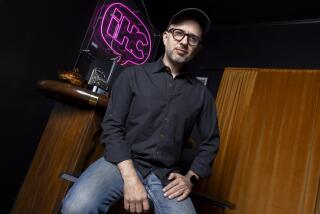Bravo, Bossa Nova!
- Share via
Deejay Bruno Guez, hair pulled back and headphones covering his ears, peers over the crowd as he rinses out a new song, a beautiful song with strings, on turntable No. 2 up in the deejay booth. The tight, hot dance floor stops to smell the romantic violin sound. Then beats and bass break in and hips sway and arms rise and Guez grins.
Message received.
Music, Beethoven is believed to have said, is a rare medium that takes you directly into the mental state of its composer. “It’s like hypnotism,” he is quoted as saying. Modern times often find music taking listeners back to the mental state of the deejay rather than the original artist, for he is the postmodern composer who dips into vinyl like a painter uses his palette. At Bossa Nova each Thursday night, the colors are blissful demonstrations of the dance genre’s new-found diversity--a celebration of, above all, good music.
Bossa Nova, held at the Pink on Main Street in Santa Monica, is in fact the premier dance music night in Los Angeles. Deejays here become aural tour guides to the upbeat vibe of Ibiza, Spain, the hypnotic house kick of New York, the progressive techno and drum-and-bass of London, the slow-burning hip-hop of Paris, the exotic dub of Goa, India. . . .
It is a rare spot in L.A. for many reasons.
Many of the city’s more prominent clubs simply have atrocious music. That may seem hard to believe in the pop culture capital. But it’s true: Hot-spot venues often cater to young Hollywood, which is enamored more with scenes than sounds. Thus, famous dance floors at places such as the Viper Room, Roxbury and the Century Club feature less-than-world-class dance music and are not in the same ballpark as spots such as New York’s Limelight and London’s Ministry of Sound. Also, the clubs in L.A. that do feature decent dance almost always feature only one genre for the night (such as house music, techno or hip-hop exclusively).
Bossa Nova, which has been going on and off for nearly three years, is the dance floor testing ground for Guez and Jason Bentley--both national dance music taste-makers, prominent local radio deejays and co-founders of Island Records’ well-received Quango Music Group imprint. Whether it’s a Quango track that is not yet released or a promo import that is impossible to find, fresh dance music is often heard here first.
A typical night at Bossa Nova usually goes something like this: Guez starts off with more experimental sounds--down-tempo, abstract hip-hop, trip-hop. . . . Bentley, arriving fresh from his weeknight radio show, “Metropolis” on KCRW-FM (89.9), mixes a nonstop set of progressive house and techno, working the crowd into a frenzy. Then deejay Jun takes the crowd past last call, spinning a smooth set of hyper-speed hip-hop, known as drum-and-bass. There are variations, of course, and the club often features top deejays from Europe.
The crowd is diverse and often peppered with European tourists. The venue is dim, slim and steamy. Lighting is basic and features a pair of “intelligent” lights that shoot around the room with computer-controlled accuracy. The sound system is usually crisp, but sometimes lacks in low-end bass. The deejay setup features three turntables--a must for some deejays, a task for others.
The only down sides to Bossa Nova are that the Pink can be quite tight at capacity (though this kind of density is the norm in New York and London); and Bossa Nova, like so many other good dance nights in L.A., is on a work night. L.A. can’t tolerate a decent dance club on the weekend. Besides, the city’s best deejays are often off spinning at big-money special events in town or in New York or London.
Perhaps it’s better that way. Well known, indeed, but Bossa Nova is still an underground state of mind.
BE THERE
Bossa Nova at the Pink, 2810 Main St., Santa Monica, (310) 392-1077. Thursdays only. 21 and over. $10.
More to Read
The biggest entertainment stories
Get our big stories about Hollywood, film, television, music, arts, culture and more right in your inbox as soon as they publish.
You may occasionally receive promotional content from the Los Angeles Times.










